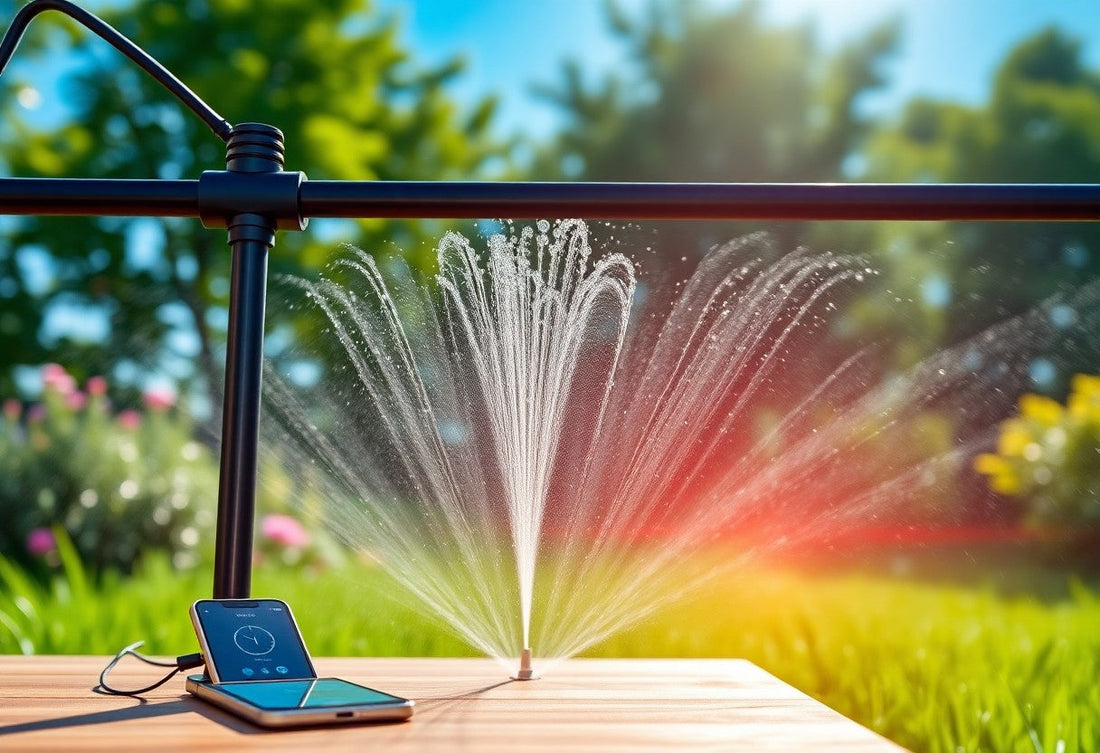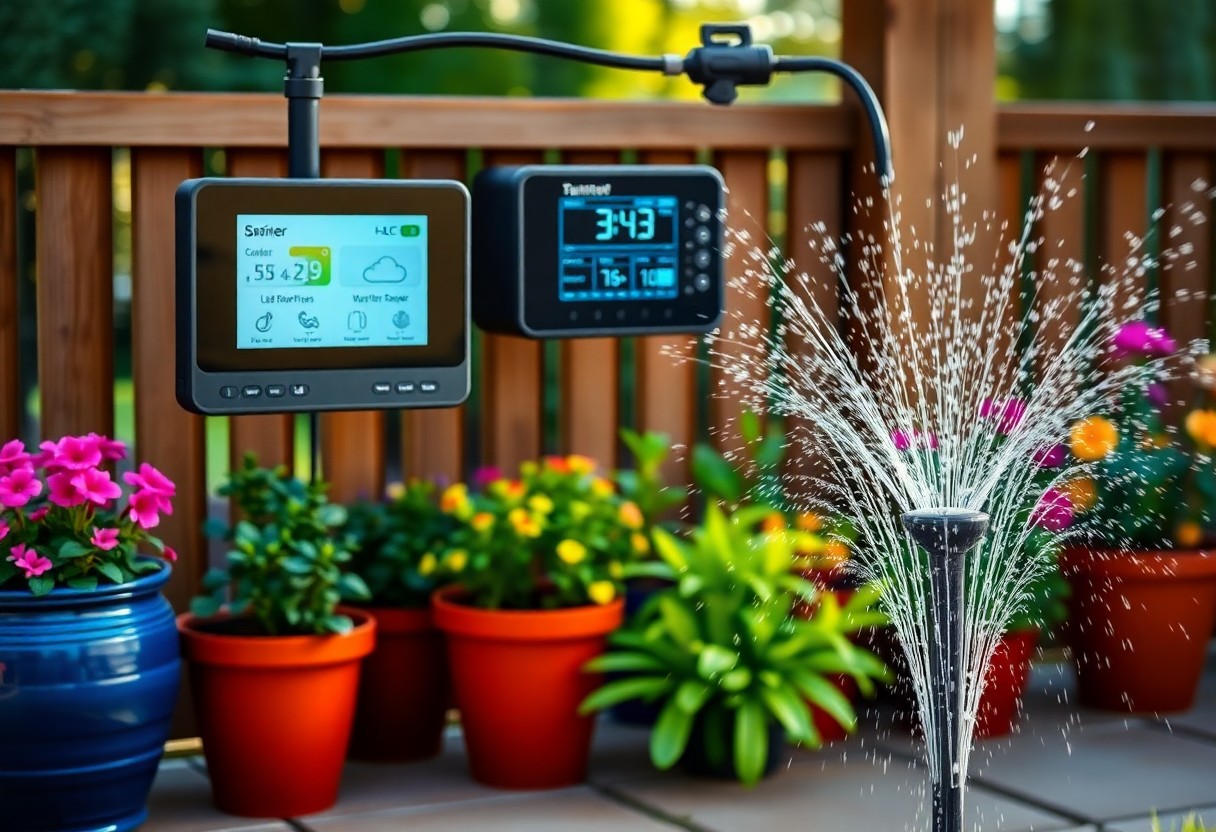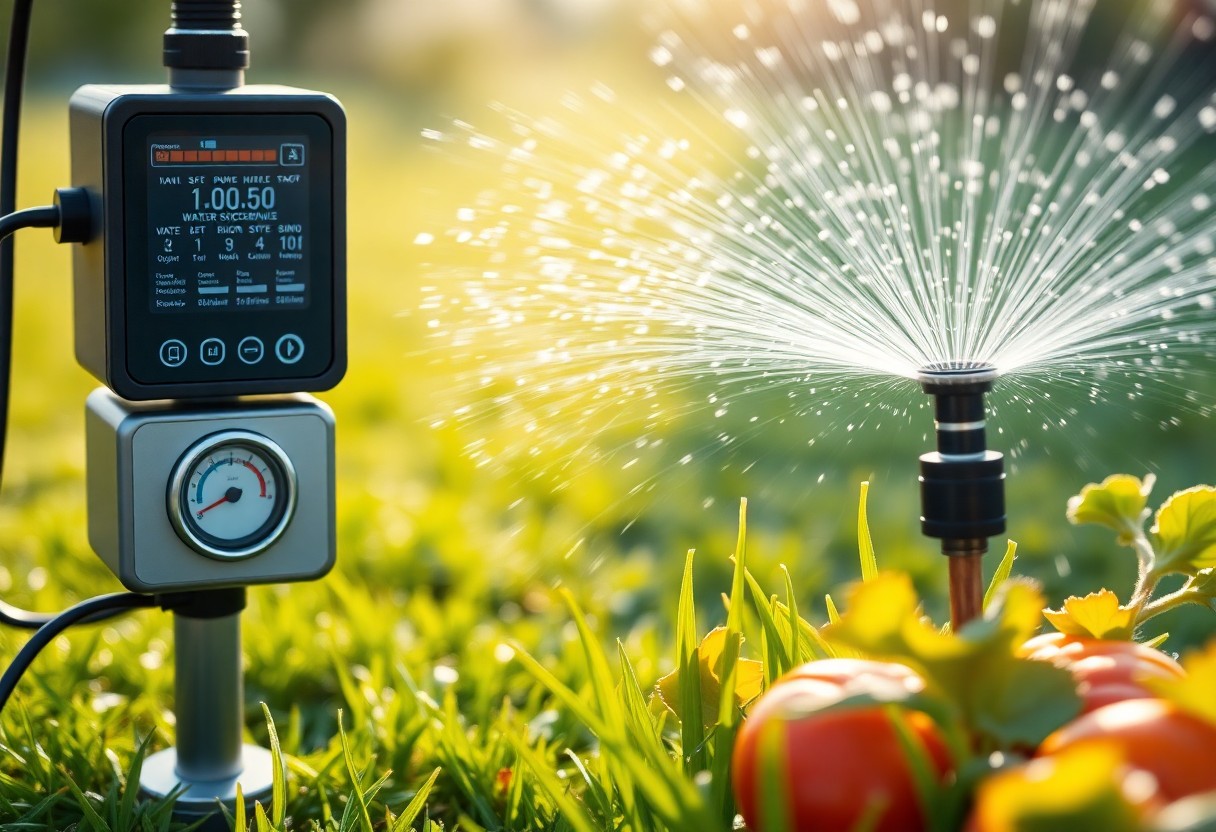
Remote-Controlled Sprinkler Systems - How To Optimize Water Usage During Heat Waves
With the increasing frequency of heat waves, it’s vital for you to manage your water resources efficiently. Remote-controlled sprinkler systems offer a convenient way to ensure your garden receives the right amount of hydration while minimizing waste. In this blog post, you will learn how to optimize these systems to not only keep your landscape healthy but also to conserve water and reduce your utility bills. Explore the latest strategies and technologies to make your irrigation practices both effective and environmentally friendly.
Key Takeaways:
- Utilize smart timers and weather sensors to adjust watering schedules based on current conditions, minimizing water waste during extreme heat.
- Implement drip irrigation systems in landscaped areas to deliver water directly to plant roots, ensuring effective hydration and reducing evaporation.
- Monitor soil moisture levels to determine when and how much to water, keeping plants healthy while conserving resources during hot spells.

Smart Irrigation Technology: The Future of Watering
The mechanics of remote-controlled systems
Remote-controlled sprinkler systems integrate smart sensors and control units, allowing you to manage your irrigation setup from anywhere. These systems often connect to your home Wi-Fi, enabling real-time monitoring and adjustments through mobile applications. With central control units that can automatically schedule watering cycles based on weather forecasts, you have precise control over your water usage, ensuring your landscape remains healthy while avoiding unnecessary waste.
Key features that enhance efficiency during heat waves
During heat waves, remote-controlled sprinkler systems showcase their true potential. Advanced features ensure efficient water distribution while adapting to the changing weather conditions. Key functionalities that enhance efficiency include:
- Weather sensors that adjust watering schedules based on real-time conditions
- Soil moisture sensors preventing overwatering
- Smart controllers that implement specific watering zones for diverse plant needs
- Remote access via mobile apps for on-the-go adjustments
Thou can optimize your irrigation strategy further by selecting systems that offer customizable settings to match your garden’s unique requirements. Consider investing in smart controllers that learn from past watering habits and environmental conditions, ensuring you provide only the necessary amount of water during extreme temperatures.
Understanding Evapotranspiration: The Science Behind Watering Needs
Defining evapotranspiration and its relevance
Evapotranspiration (ET) represents the sum of evaporation and plant transpiration from the land to the atmosphere. This process plays a critical role in determining your watering needs, especially during heat waves when ET rates soar. By understanding ET, you can tailor your sprinkler system to provide just the right amount of water for your landscape, ensuring optimal growth while conserving this vital resource.
Factors influencing water demands in extreme heat
Several interrelated factors dictate how much water your landscape requires during extreme heat. Temperature, humidity, wind speed, and sunlight all contribute to the rate of evapotranspiration. Additionally, specific plant species exhibit varying levels of water demand, influenced by root depth and soil type. Monitoring these elements is vital for efficient water management. Assume that
- Higher temperatures typically result in increased evapotranspiration rates.
- Low humidity can further elevate evaporation from soil surfaces.
- Windy conditions may increase transpiration by accelerating moisture loss from foliage.
- Different soil types drain and retain water differently, affecting your watering strategy.
- Plant physiology, such as leaf area and growth stage, influences water uptake.
In extreme heat, water demands can shift dramatically. For example, a 2-degree rise in temperature may increase ET rates by 10%, making it vital to monitor your landscape closely. Additionally, container plants often require more frequent watering compared to plants in the ground due to limited soil moisture. Effective adjustments may involve increasing watering frequency or durations while leveraging your automated systems for precise scheduling. Assume that
- Plant species vary in their drought tolerance, requiring tailored strategies.
- Soil moisture sensors can help you avoid over or under-watering.
- Seasonal mulching can reduce surface evaporation and improve water retention.
Customization Mechanics: Tailoring Your System for Optimal Performance
Setting schedules based on plant needs
Adjust your watering schedules according to the specific needs of your plants. Different varieties require varying amounts of hydration; for instance, succulents thrive on less water, while lush gardenias demand more. Utilizing evapotranspiration data, you can set precise watering times and durations aimed at optimizing growth without over-watering. Regularly modifying these schedules as seasons change will help conserve water while keeping your garden vibrant.
Zone management: groupings based on water requirements
Effective zone management is key to optimizing water usage across different areas of your landscape. By grouping plants with similar watering needs, you can create specific zones that receive targeted irrigation, reducing waste and ensuring each plant thrives.
For example, consider a typical garden layout: you could create a zone for drought-tolerant plants, another for hibiscus and other moisture-loving flowers, and yet another for your vegetable patch, which generally requires frequent watering. By tailoring your sprinkler system to recognize these zones, you can employ varied run times or intensity levels for each zone. This tailored approach means your drought-resistant plants won’t suffer from over-saturation, while your thirsty blooms satisfy their moisture requirements. The result is a healthier garden ecosystem and significant water savings during heat waves.
Real-Time Monitoring: Harnessing Data for Precision
Sensors that track soil moisture and weather conditions
Soil moisture sensors provide critical insights into your garden’s hydration needs, measuring moisture levels at various depths to help you make informed decisions. Coupled with weather condition sensors that assess temperature, humidity, and precipitation, these tools enable you to adjust watering schedules precisely. This synchronization ensures that you’re not overwatering during a rainy spell or under-watering during dry, hot days, thereby maximizing water efficiency.
Integrating mobile apps for user-friendly control
Mobile apps can simplify the management of your sprinkler systems, allowing you to control and monitor them from anywhere. These applications provide real-time data about your watering schedules, sensor readings, and even forecasts that help you proactively adjust settings to optimize water usage.
By using mobile apps, you gain access to user-friendly dashboards displaying moisture levels, weather updates, and system alerts. Most apps allow you to customize watering times, adjust spray patterns, and program schedules tailored to specific plants in your garden. The convenience of pushing a few buttons means you can keep your landscape flourishing without wasting resources, making effective water management easier than ever. Plus, many apps offer features like automated watering adjustments based on real-time weather forecasts, ensuring your plants receive just the right amount of hydration according to current conditions.
Maximizing Resource Use: Rainwater Harvesting and Other Synergies
Systems that collect and utilize rainwater
Integrating rainwater harvesting systems into your outdoor water management strategy can significantly reduce dependency on municipal water sources. By capturing rainwater from your roof and directing it to a storage tank, you can store thousands of gallons that can be used for irrigation. These systems can often be automated, allowing you to sync them with your remote-controlled sprinkler setup, optimizing both the collection and usage of this precious resource during heat waves.
Combining irrigation strategies for sustainability
Selecting the right combination of irrigation methods enhances water use efficiency and supports sustainability. For instance, pairing drip irrigation with your remote-controlled system allows for targeted watering directly at the base of plants, minimizing evaporation and runoff. Integrating smart controllers that adapt irrigation schedules based on current weather data can also ensure your plants receive just the right amount of water, especially during periods of high heat.
This multi-faceted approach not only maximizes water conservation but also minimizes waste. Utilizing drip irrigation together with a rainwater harvesting system creates a resilient framework for sustainable landscaping. Studies suggest that drip irrigation can use up to 60% less water than traditional sprinkler systems. Furthermore, combining your rainwater supply with advanced weather-sensing technology enables you to remain adaptive, adjusting for rainfall patterns while maintaining optimal soil moisture throughout varying climatic conditions.

Common Challenges: Troubleshooting Your Remote-Controlled System
Wireless connectivity issues and solutions
Wireless connectivity can sometimes falter due to interference from other devices or physical barriers. To mitigate this, ensure your router is placed centrally and away from obstructions. You might also consider using a mesh network to enhance Wi-Fi coverage. If you frequently encounter issues, upgrading to a dual-band router can improve connectivity, providing you with both 2.4 GHz and 5 GHz bands for more reliable communication between your sprinkler system and the control interface.
Dealing with system malfunctions during critical periods
System malfunctions can wreak havoc on your watering schedule, particularly during heat waves when your plants require the most hydration. When issues arise, assess your system promptly, starting with basic checks like power supply, connectivity, and settings to identify immediate problems. Creating a detailed maintenance plan—including routine checks and troubleshooting protocols—helps ensure your system is responsive even during high-stress periods.
During critical periods, swift action becomes the name of the game. If your system fails while temperatures peak, a backup plan is crucial. For instance, having a manual override can allow you to water your plants until connectivity or functionality is restored. Keeping crucial tools like a compatible app on your mobile device can also ensure you're always in control, helping reduce stress on your garden and providing peace of mind when issues arise. Regularly testing your system before peak seasons can prevent these last-minute emergencies, keeping your greenery thriving despite the heat.
Financial Implications: Cost Savings and Water Conservation
Analyzing the economic benefits of advanced irrigation systems
Investing in remote-controlled sprinkler systems can lead to significant economic benefits for you. These advanced irrigation systems not only automate watering schedules but can also help optimize water usage. This efficiency translates into lower water bills and reduced resource waste. According to studies, homeowners have seen up to a 30% decrease in water consumption after investing in smart irrigation technology.
Cost Savings Breakdown
| Cost Component | Potential Savings |
|---|---|
| Water Bills | 30% reduction |
| Maintenance Costs | 20% reduction |
| Fertilizer Usage | 15% reduction |
| System Efficiency Loss | 10% increase in lifespan |
Evaluating long-term savings on water bills and maintenance
Over time, you’ll notice a dramatic reduction in your water bills, thanks to the efficiency of smart sprinklers. These systems adapt to weather changes and only water your lawns when necessary, conserving resources while keeping your landscape healthy. In addition to lower monthly water expenses, advanced systems typically require less maintenance than traditional sprinklers, leading to further savings.
Beyond immediate savings, remote-controlled sprinkler systems can extend the lifespan of your irrigation setup. With routine maintenance and minimal manual adjustments needed, the likelihood of needing costly repairs diminishes significantly. Those who switched to smart irrigation systems frequently report not only reduced water bills but a noticeable decline in general landscaping expenses, making these systems a financially savvy choice for long-term sustainability. All things considered, maximizing your water usage efficiency during heat waves leads to more than just water conservation; it also bolsters your budget for years to come.
Looking Ahead: Innovations in Smart Irrigation
Emerging technologies and their potential impact
New technologies are rapidly evolving within the smart irrigation field, promising to revolutionize how you manage your watering methods. The emergence of satellite imaging, soil moisture sensors, and real-time data analytics can enhance the precision and efficiency of irrigation, allowing you to conserve water and optimize your landscape. These innovations not only help you make informed decisions but also have the potential to reduce labor costs significantly while bolstering crop yields and improving overall landscape health.
The role of AI and machine learning in optimizing irrigation
AI and machine learning algorithms are making strides in irrigation management. By analyzing large datasets—including weather patterns, soil moisture levels, and plant health—these technologies can formulate tailored watering schedules, ensuring that every drop is used effectively. This leads to greater water conservation and enhanced landscape vitality.
Utilizing AI and machine learning means you can set up systems that learn from past irrigation cycles and adapt in real-time to changing environmental conditions. For example, a machine learning model could predict optimal watering times based on humidity levels and temperature forecasts, importantly turning your irrigation system into a highly efficient, self-operating entity. Some smart irrigation systems already integrate these capabilities to adjust schedules dynamically, allowing for optimal water usage even during a heat wave. By leveraging predictive analytics, you can ensure your plants thrive while significantly reducing water waste.
To wrap up
On the whole, optimizing your remote-controlled sprinkler system during heat waves can significantly enhance your water usage efficiency. By scheduling watering during cooler parts of the day, utilizing smart sensors, and adjusting settings based on weather forecasts, you can ensure your garden remains healthy while conserving this precious resource. Investing time in fine-tuning your system not only benefits your landscape but also contributes to broader water conservation efforts. With the right adjustments, you can strike a balance between maintaining your yard's beauty and reducing water waste.
FAQ
Q: How can I schedule my remote-controlled sprinkler system to use less water during heat waves?
A: To optimize water usage during heat waves, you can program your remote-controlled sprinkler system to operate during cooler times of the day, such as early morning or late evening. This reduces evaporation and enhances water absorption. Additionally, adjust the duration of each watering session based on the weather forecasts and soil moisture levels. Many smart sprinkler systems allow you to set watering schedules based on real-time weather data, ensuring efficient water usage.
Q: What strategies can I implement to check the performance of my sprinkler system during extreme heat?
A: Regularly inspect the sprinkler system for any clogs or leaks that may waste water. Conduct a simple catch can test by placing several containers around your lawn to measure the amount of water delivered during a watering cycle. This helps you assess if your system distributes water evenly. Make adjustments to the sprinkler heads as necessary to correct any irregularities. It’s also beneficial to use soil moisture sensors to ensure watering occurs only when needed, promoting efficient use of water.
Q: Are there any types of plants or grass that require less water during hot weather when using a remote-controlled sprinkler system?
A: Yes, selecting drought-resistant plants and grasses can significantly reduce overall water usage, especially during heat waves. Native plants are typically well-adapted to local climate conditions and may thrive with minimal irrigation. Opting for turf varieties like zoysia or Bermuda grass can also help as they tend to require less water than other varieties. Enhancing your garden with mulch can further aid in moisture retention, allowing you to minimize the frequency and duration of watering sessions with your sprinkler system.
